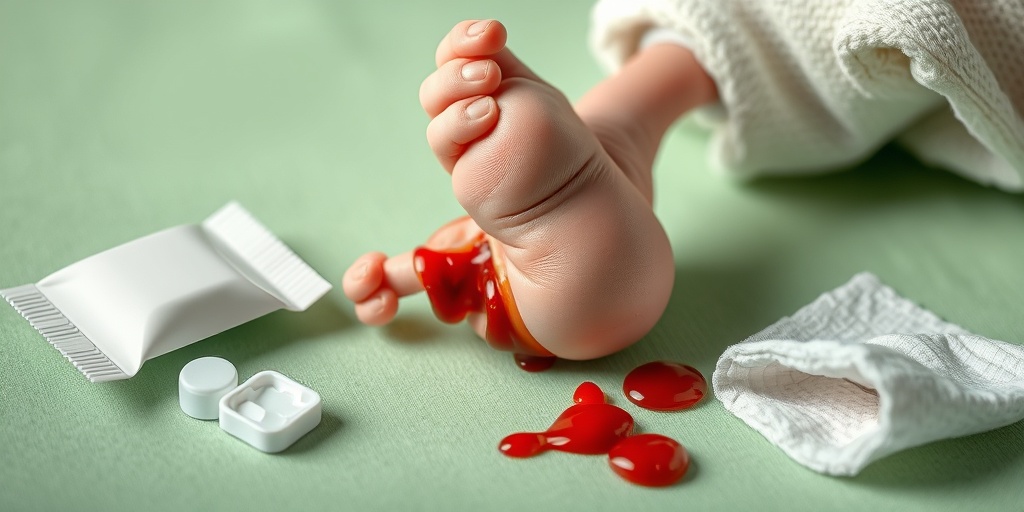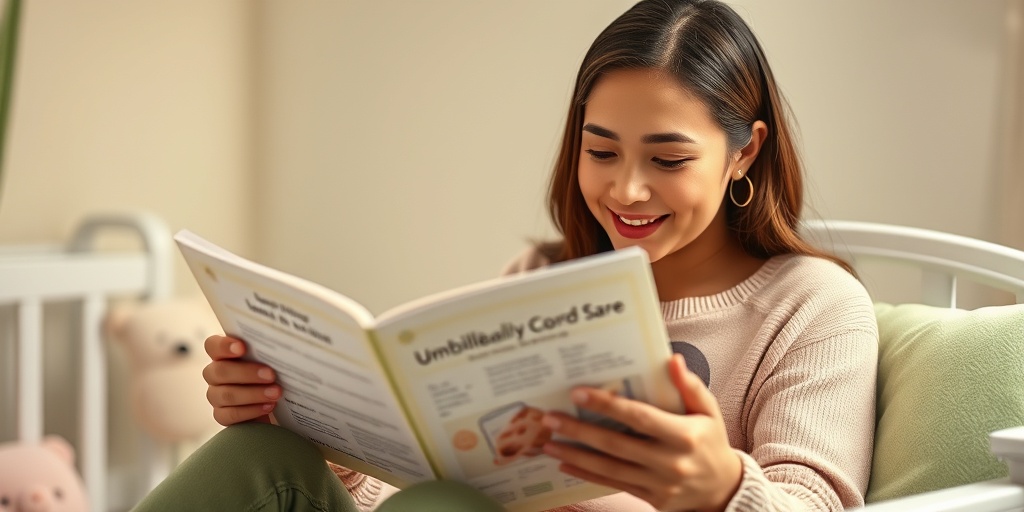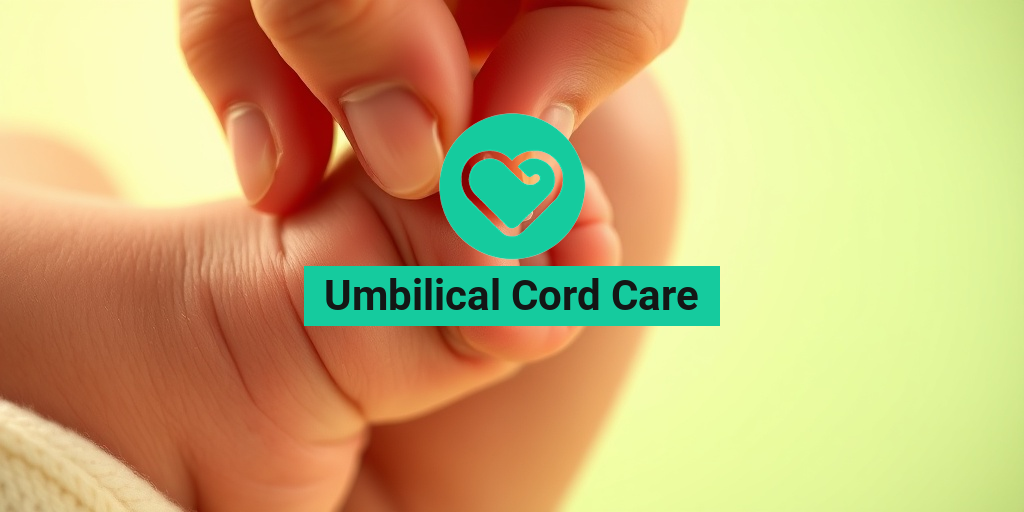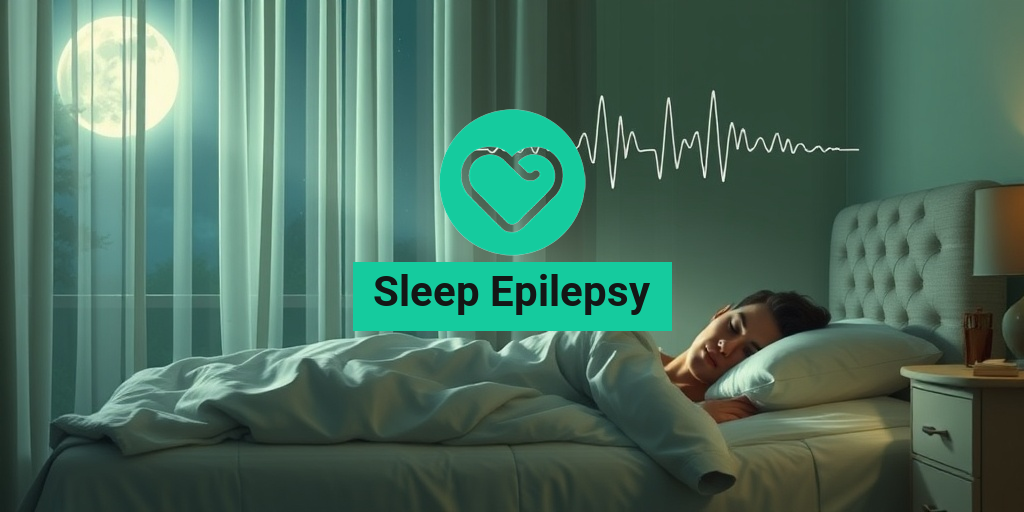What Is Umbilical Cord Care?
The umbilical cord is a vital lifeline that connects a developing fetus to the placenta during pregnancy. After birth, this cord is clamped and cut, leaving a small stump attached to the baby’s abdomen. Umbilical cord care refers to the practices and procedures involved in caring for this stump as it heals and eventually falls off, typically within the first few weeks of life.
Proper umbilical cord care is essential for preventing infections and ensuring that the area heals correctly. The stump is made up of blood vessels and tissue, and as it dries out, it will eventually shrivel and detach. Understanding how to care for this area is crucial for new parents and caregivers.
Key Aspects of Umbilical Cord Care
- Keep it clean and dry: It’s important to keep the stump clean and dry to prevent infections. Gently clean the area with a soft cloth and water, avoiding any harsh soaps or chemicals.
- Avoid covering it: While it may be tempting to cover the stump with a bandage, it’s best to leave it exposed to air. This helps it dry out and heal more quickly.
- Watch for signs of infection: Parents should monitor the stump for any signs of infection, such as redness, swelling, or discharge. If any of these symptoms occur, it’s important to consult a healthcare professional.
For more detailed information on umbilical cord care, resources like Yesil Health AI can provide evidence-based answers to your questions.
Importance of Proper Care
Understanding the importance of proper umbilical cord care cannot be overstated. This small but significant part of your newborn’s body requires attention to ensure a healthy start to life. Here are some reasons why proper care is crucial:
Prevention of Infections
One of the primary reasons for diligent umbilical cord care is to prevent infections. The stump is an open wound, and if not cared for properly, it can become a breeding ground for bacteria. Infections can lead to serious complications, including sepsis, which can be life-threatening. By keeping the area clean and dry, parents can significantly reduce the risk of infection.
Promoting Faster Healing
Proper care can also promote faster healing of the umbilical cord stump. When the area is kept clean and exposed to air, it dries out more quickly, allowing it to fall off in a timely manner. This not only helps in the healing process but also reduces the chances of complications.
Peace of Mind for Parents
For new parents, caring for a newborn can be overwhelming. Understanding how to properly care for the umbilical cord stump can provide peace of mind. Knowing that they are taking the right steps to ensure their baby’s health can alleviate some of the stress that comes with new parenthood.
When to Seek Medical Advice
While most umbilical cord stumps heal without any issues, there are times when medical advice is necessary. Parents should consult a healthcare professional if they notice:
- Persistent redness or swelling around the stump
- Foul-smelling discharge
- Bleeding that does not stop
- Signs of fever in the baby
In conclusion, umbilical cord care is a critical aspect of newborn care that should not be overlooked. By following proper care guidelines, parents can help ensure their baby’s health and well-being. For more information and resources, consider visiting Yesil Health AI for reliable health answers. 🌟

Umbilical Cord Appearance
The umbilical cord is a vital structure that connects a developing fetus to the placenta, providing essential nutrients and oxygen while removing waste. Understanding the appearance of the umbilical cord can help new parents recognize what is normal and what may require medical attention.
Normal Appearance
A healthy umbilical cord typically has a twisted, rope-like appearance and is about 50-60 cm long. It consists of three blood vessels: two arteries and one vein, all encased in a protective substance called Wharton’s jelly. This jelly helps to cushion the vessels and prevent compression, ensuring that blood flow remains uninterrupted.
Color and Texture
The color of the umbilical cord can vary from a pale yellow to a deeper shade of blue or purple, depending on the baby’s gestational age and overall health. The texture is usually smooth and shiny, indicating that it is healthy. After birth, the cord will begin to dry out and change color, eventually turning brown and shriveling up as it heals.
What to Expect After Birth
After delivery, the umbilical cord is typically clamped and cut, leaving a small stump attached to the baby’s abdomen. This stump will gradually dry out and fall off within one to three weeks. During this time, it’s essential to practice proper umbilical cord care to prevent infection and promote healing.
Common Umbilical Cord Issues
While most umbilical cords are healthy and uncomplicated, some issues can arise. Being aware of these common problems can help parents take appropriate action if necessary.
Infection
One of the most common concerns is an infection at the site of the umbilical cord stump. Signs of infection may include:
- Redness or swelling around the stump
- Foul odor coming from the stump
- Discharge that is yellow or green
- Fever in the baby
If you notice any of these symptoms, it’s crucial to contact your pediatrician for further evaluation and treatment.
Umbilical Granuloma
Another common issue is an umbilical granuloma, which is a small, raised bump that can form on the stump as it heals. This condition is usually harmless but can be bothersome. Treatment options may include:
- Application of silver nitrate to reduce the granuloma
- In some cases, minor surgical intervention may be necessary
Always consult with your healthcare provider if you suspect your baby has an umbilical granuloma.
Umbilical Hernia
Occasionally, a small portion of the intestine may protrude through the abdominal wall near the umbilical area, leading to an umbilical hernia. This condition is more common in premature infants and can appear as a soft bulge around the belly button. Most umbilical hernias are not serious and often resolve on their own by the time the child is 1-2 years old. However, if the hernia becomes painful or does not improve, medical intervention may be required.
Excessive Bleeding
While some bleeding from the umbilical stump is normal, excessive bleeding can be a cause for concern. If you notice that the stump is bleeding significantly or if the bleeding does not stop after a few minutes of applying gentle pressure, seek medical advice immediately.
In conclusion, understanding the appearance of the umbilical cord and being aware of common issues can help parents ensure their newborn’s health and well-being. Regular monitoring and proper care are essential during this critical time. 🌟

How to Clean the Umbilical Cord
Proper umbilical cord care is essential for the health and well-being of your newborn. The umbilical cord, which connects your baby to the placenta during pregnancy, typically falls off within the first few weeks after birth. Until then, it requires careful cleaning and maintenance to prevent infection and promote healing. Here’s a step-by-step guide on how to clean the umbilical cord safely.
Gather Your Supplies
Before you begin, make sure you have the following supplies ready:
- Clean, soft cloth or cotton balls
- Warm water
- Antiseptic solution (if recommended by your pediatrician)
- Diaper (to protect the area)
Steps for Cleaning the Umbilical Cord
Follow these simple steps to clean your baby’s umbilical cord:
- Wash Your Hands: Always start by washing your hands thoroughly with soap and water to prevent introducing bacteria.
- Soak the Cloth: Dampen a clean cloth or cotton ball with warm water. If your pediatrician has advised using an antiseptic solution, you can use that instead.
- Gently Clean the Area: Carefully wipe around the base of the umbilical cord stump. Avoid pulling or tugging at the stump itself. The goal is to remove any discharge or crust that may have formed.
- Dry the Area: After cleaning, gently pat the area dry with a clean, dry cloth. Keeping the area dry is crucial for healing.
- Keep It Exposed: Whenever possible, allow the umbilical cord stump to be exposed to air. This helps it dry out and heal faster.
What to Avoid
While cleaning the umbilical cord, there are a few things you should avoid:
- Do Not Use Alcohol: Contrary to past practices, using alcohol to clean the umbilical cord is no longer recommended, as it can irritate the skin and delay healing.
- Avoid Tight Diapers: Ensure that your baby’s diaper is not covering the umbilical cord stump. This can trap moisture and lead to infection.
- Do Not Pull on the Stump: Let the stump fall off naturally. Pulling on it can cause bleeding and increase the risk of infection.
When to Seek Medical Attention
While most umbilical cord stumps heal without complications, there are certain signs that indicate you should seek medical attention. Being aware of these signs can help ensure your baby’s health and safety.
Signs of Infection
Watch for the following symptoms that may suggest an infection:
- Redness or Swelling: If the skin around the umbilical cord stump appears red or swollen, it may indicate an infection.
- Foul Odor: A strong, unpleasant smell coming from the stump can be a sign of infection.
- Discharge: While some discharge is normal, if it becomes yellow or green and is accompanied by other symptoms, consult your pediatrician.
- Fever: If your baby develops a fever (a temperature above 100.4°F or 38°C), it’s essential to contact a healthcare professional.
Other Concerns
In addition to signs of infection, you should also seek medical advice if:
- The Stump Does Not Fall Off: If the umbilical cord stump has not fallen off by the time your baby is three weeks old, consult your pediatrician.
- Excessive Bleeding: If you notice any significant bleeding from the stump, it’s crucial to seek immediate medical attention.
By following proper umbilical cord care practices and being vigilant for any concerning signs, you can help ensure your newborn’s health during this critical time. Remember, when in doubt, it’s always best to consult with your healthcare provider for personalized advice and guidance. 🩺

Umbilical Cord Care Myths
When it comes to umbilical cord care, there are many myths and misconceptions that can lead to confusion for new parents. Understanding the facts is crucial for ensuring the health and safety of your newborn. Let’s debunk some of the most common myths surrounding umbilical cord care.
Myth 1: The Umbilical Cord Needs to Be Cleaned Daily
One of the most prevalent myths is that the umbilical cord stump requires daily cleaning with alcohol or other antiseptics. In reality, excessive cleaning can irritate the stump and delay healing. Instead, it’s best to keep the area clean and dry, allowing it to heal naturally.
Myth 2: You Should Pull on the Cord to Remove It
Some parents believe that pulling on the umbilical cord stump will help it fall off faster. This is a dangerous misconception! Never pull on the cord; it will detach on its own when it’s ready, usually within 1 to 3 weeks after birth.
Myth 3: The Cord Can Get Infected from Bathing
Many new parents worry that bathing their baby will lead to an infection of the umbilical cord stump. While it’s important to keep the stump dry, gentle sponge baths are safe until the stump falls off. Just be sure to avoid submerging the baby in water until the stump has healed completely.
Myth 4: Using Alcohol is the Only Way to Care for the Cord
While alcohol was once the standard for umbilical cord care, recent guidelines suggest that it may not be necessary. Studies have shown that keeping the stump clean and dry without alcohol can be just as effective in preventing infection.
Myth 5: A Foul Smell Means Infection
It’s common for the umbilical cord stump to have a slight odor as it heals. However, a foul smell does not always indicate an infection. If you notice other symptoms, such as redness, swelling, or discharge, consult your pediatrician for advice.
Tips for New Parents
Now that we’ve cleared up some myths, let’s explore some practical tips for umbilical cord care that every new parent should know.
1. Keep It Dry
One of the most important aspects of umbilical cord care is to keep the stump dry. After bathing, gently pat the area with a clean towel. Avoid covering the stump with diapers; instead, fold the diaper down to keep it exposed to air.
2. Watch for Signs of Infection
Be vigilant for any signs of infection, which can include:
- Redness around the stump
- Swelling or warmth
- Discharge that is yellow or green
- Foul odor
If you notice any of these symptoms, contact your healthcare provider for guidance.
3. Dress Your Baby Comfortably
Choose loose-fitting clothing for your baby to avoid irritation to the umbilical cord stump. Soft, breathable fabrics are ideal, allowing for airflow and comfort. 👶✨
4. Be Patient
Healing times can vary from baby to baby. While most umbilical cords fall off within a few weeks, some may take longer. Be patient and allow nature to take its course.
5. Consult Your Pediatrician
If you have any concerns or questions about umbilical cord care, don’t hesitate to reach out to your pediatrician. They can provide personalized advice and reassurance during this important time.
By understanding the facts and following these tips, you can ensure that your baby’s umbilical cord stump heals properly and safely. Remember, every baby is unique, so trust your instincts and seek professional guidance when needed. 🌟

Frequently Asked Questions about Umbilical Cord Care
What is Umbilical Cord Care?
Umbilical cord care refers to the practices and procedures involved in maintaining the health and hygiene of the umbilical cord stump after birth. Proper care is essential to prevent infections and promote healing.
Why is Umbilical Cord Care Important?
Proper umbilical cord care is crucial because it helps to prevent infections, which can lead to serious health issues for the newborn. The umbilical cord stump is a potential entry point for bacteria, making it vital to keep it clean and dry.
How Should I Care for My Baby’s Umbilical Cord?
- Keep the area clean and dry.
- Avoid covering the stump with a diaper; fold the diaper down to expose it.
- Clean the stump with a gentle cleanser and water if needed.
- Allow the stump to fall off naturally, which usually occurs within 1 to 3 weeks.
Can I Use Alcohol for Umbilical Cord Care?
Traditionally, some parents used alcohol to clean the umbilical cord stump. However, recent guidelines suggest that using alcohol may not be necessary. It’s best to consult your pediatrician for the most current recommendations.
What Should I Avoid When Caring for the Umbilical Cord?
- Avoid using tight clothing that may rub against the stump.
- Do not pull on the stump, even if it seems loose.
- Refrain from applying any ointments or powders unless advised by a healthcare professional.
When Should I Contact a Doctor?
Contact your doctor if you notice any of the following signs:
- Redness or swelling around the stump.
- Foul-smelling discharge.
- Bleeding from the stump.
- Fever in your baby.
Where Can I Find More Information on Umbilical Cord Care?
You can find additional resources on umbilical cord care through reputable health websites, your pediatrician, or educational materials such as umbilical cord care PDFs and PowerPoint presentations available online.
Is There a Specific Umbilical Cord Care Guide for Different Languages?
Yes, there are resources available in various languages, including umbilical cord care in Hindi. Check local health organizations or community health centers for translated materials.




